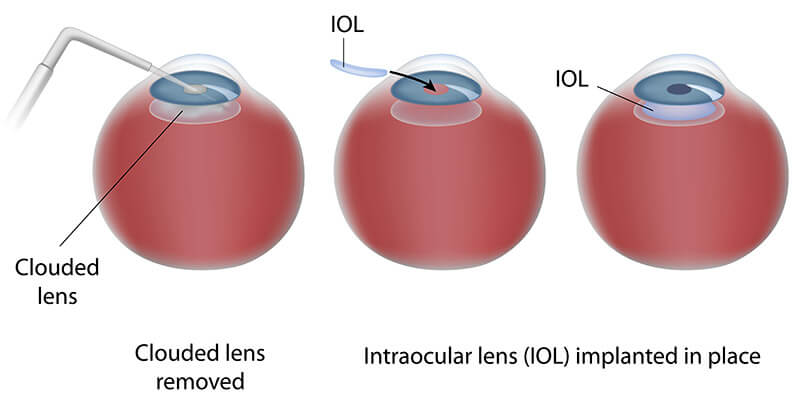During cataract surgery, artificial lenses are implanted in the eye to replace the cloudy natural lenses. These artificial lenses, known as intraocular lenses (IOLs), were once only able to correct distance vision, leaving patients dependent on eyeglasses or contact lenses for near vision. Many cataract patients, in addition to suffering from either nearsightedness or farsightedness, also suffer from presbyopia, natural changes to the eyes that occur as we age.
Before advanced technology lenses, patients were unable to see clearly at both near and far distances without the use of eyeglasses or contact lenses. Early lens implants were monofocal, meaning that they had only one focal point and could not adjust to varying distances.
New advances in technology have allowed for the development of multifocal IOLs, which let patients see clearly at all distances, and can even correct astigmatism as well. Advanced technology lens implants are ideal for cataract patients who are also suffering from presbyopia and want a replacement lens that provides a full range of clear vision.

There are several different types of advanced technology lens implants available for cataract patients. Your doctor will work with you to decide which lens is best for your individual eyes to help you enjoy long-lasting, clear vision at near, intermediate and far distances. To speak with one of our doctors and discuss your options for cataract replacement lenses, please call us today to schedule a consultation.
Patients who are nearsighted or farsighted can usually have these visual problems corrected at the time of traditional cataract surgery using a standard or monofocal intraocular lens (IOL). These patients often have great distance vision without glasses but depend on reading glasses up close.
With custom cataract surgery however, the goal is to improve vision and decrease dependence on glasses or bifocals. The majority of patients who choose custom cataract surgery report that they can read a book or magazine, work on the computer, drive in daylight or night, play golf and tennis with increased freedom from glasses. Custom cataract surgery addresses two conditions: astigmatism and presbyopia.
When the surface of the cornea has an uneven curvature, vision becomes distorted. This irregularity is called corneal astigmatism. A person who has both a cataract and corneal astigmatism will not have clear distance vision after cataract surgery unless the astigmatism is also corrected.
There are several options your surgeon can choose from to correct astigmatism, including Lasik vision correction or limbal relaxing incisions. At the time of the cataract surgery however, your surgeon can choose a special astigmatism correcting intraocular lens called a Toric intraocular lens. This is an implantable lens that makes it possible to treat the cataract and correct corneal astigmatism at the same time.
Presbyopia is an age-related condition that most people over the age of 40 experience. This condition results in the difficulty seeing up close without bifocals or reading glasses. Patients who have traditional cataract surgery with standard monofocal intraocular lenses develop “instant presbyopia”, because these intraocular lenses focus at only one distance. Most patients usually need glasses for near and intermediate distance. By choosing custom cataract with a presbyopia correcting intraocular lens however, patients are usually much less dependent on glasses or bifocals at all distances. If you are considering cataract surgery, you may be a candidate for custom cataract surgery with a presbyopic correcting intraocular lens that can provide a full range of vision. This means that one may see clearly at distance, near and in-between with little or no dependence on bifocals or reading glasses. There are several types of presbyopia correcting intraocular lenses. Your surgeon will take careful measurements of your eye and discuss with you your lifestyle needs. You and your surgeon will then decide together which lens is the best for you.

The Tecnis Multifocal intraocular lens (IOL) can be used for those patients with or without presbyopia who want to have near, intermediate and distance vision without relying on glasses or contact lenses. Cataract surgery, which replaces the eye’s cataract-impaired lens with an artificial clear lens (IOL) is the most commonly performed surgical procedure in the United States.
The Tecnis IOL was designed to provide cataract surgery patients with a high-quality vision similar to that of a younger person. The Tecnis IOL is meant to improve functional vision – the ability to see objects in varying light conditions – especially at night and twilight and in rain, snow and fog. This means improved night vision and reduction of spherical aberrations, an undesirable scattering of light that is a common side effect of cataract surgery.
Unlike other multifocal IOLs, the Tecnis Multifocal IOL provides the following benefits:
The Tecnis IOL is ideal for cataract patients who have one or more of the following symptoms:
The doctor will determine whether or not this lens is right for the patient after a comprehensive eye exam and an evaluation of their medical history and the goals they want to achieve with the surgery.
The cataract-impaired lens of the eye is gently removed through a tiny incision that is made on the edge of the cornea. The lens is then removed and replaced with the Tecnis IOL. The procedure takes between 15 to 45 minutes to complete.
Following the procedure, patients will be able to return home after about an hour of observation. A follow-up appointment is usually scheduled for the day after the surgery to monitor the patient’s recovery. Recovery from the surgery is usually short, and most patients are able to return to their normal activities almost immediately.
There may be some itching, discomfort and sensitivity to light after surgery, which can be managed through eye drops that have been prescribed by the doctor. These symptoms usually go away within a few days as the eye heals and patients can begin to enjoy the many benefits of their new vision.
As with any surgery, Tecnis Multifocal lens surgery has potential complications. The most common side effects of all cataract procedures include:
These risks, however, are rare and are often outweighed by the potential benefits of restoring vision.
Complications specific to Tecnis Multifocal lenses may include:
Unlike rigid lenses, the flexible silicone Crystalens features hinges that allow it to move with the eye’s muscles and accommodate seamlessly, thereby reducing or eliminating the need for vision correction.
The Crystalens is implanted using the same, nearly risk-free cataract surgery techniques as with other IOLs.
Most people with cataracts or who have had corneal refractive surgery and retained good eye health are acceptable candidates for Crystalens implantation, but those who have already had cataract surgery are not. People with eye health problems such as chronic infections or diabetes should check with their doctors about eligibility.

Physicians have been using flexible IOLs for years to replace the eye’s cloudy lens during cataract surgery and help patients enjoy clear vision again. The ReSTOR® lens improves upon the ordinary IOL by using apodized diffractive technology to provide a full range of focusing distances from near to far. A series of 12 gradual “step heights” of 0.2-1.3 microns each (thinner than a human hair and smaller than a red blood cell) in the center of the IOL create seamless focusing ability, while the peripheral refractive region helps to enhance distance vision. Apodization also allows the lens to work with the pupil to distribute light evenly in the eye in different lighting conditions and activity levels. Alcon® reports that up to 80% of patients who use the ReSTOR® lens don’t need glasses after surgery.

Intraocular lenses are used to correct vision problems during cataract surgery by replacing the old, damaged lens with an artificial lens that clears up and corrects vision, often leaving patients with little to no dependence on glasses. While cataract surgery corrects cloudy lenses, it still leaves patients with astigmatism with distorted vision. Toric IOLs are specially designed to correct astigmatism along with overall vision during cataract surgery, offering complete vision correction.
Before Toric IOLs, people with astigmatism would need to undergo corneal refractive surgery after their lenses were implanted, or would remain dependent on glasses or contact lenses. The advanced Toric IOLs correct the imbalance caused by an irregular cornea shape in patients with astigmatism. There are several different types of FDA approved Toric IOLs, including AcrySof® Toric Lenses, which can correct up to 3 or more diopters of astigmatism.
The risks of a Toric IOL include poor vision as a result of the lens rotating out of position, although this risk exists with any type of intraocular lens. Toric IOLs are considered safe for most patients with astigmatism and are the only solution to correct vision problems associated with both cataracts and astigmatism. Talk to your doctor to learn more about these lenses and find out if you can enjoy the benefits of Toric IOLs.

160 Boston Ave.,
Altamonte Springs, FL 32701
2460 E Highway 50,
Clermont, FL 34711
10131 W Colonial Drive,
Ocoee, FL 34761
2917 Edgewater Drive,
Orlando, FL 32804
2875 Maguire Road,
Windermere, FL 34768
2225 North Central Avenue,
Kissimmee, FL 34741
7975 Lake Underhill Road, Suite #140
Orlando, FL 32822
345 West Michigan Street,
Orlando, FL 32806
787 Health Care Drive,
Orange City, FL 32763
5727 Canton Cove,
Winter Springs, FL 32708